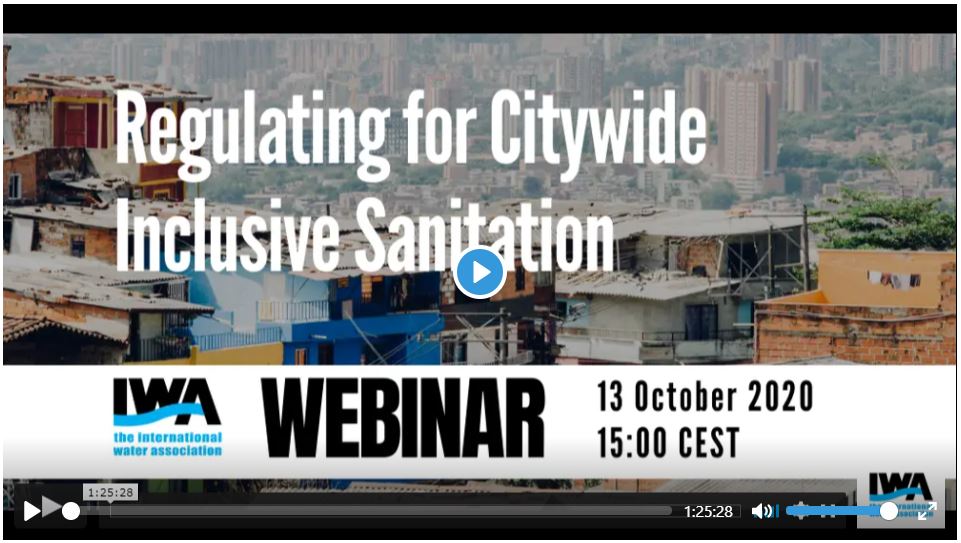World Toilet Day: CWIS Through Regulation
Catalysing Citywide Inclusive Sanitation Through Regulating Service Providers
This article is part of a series for World Toilet Day highlighting issues within the WHO-UNICEF State of the World’s Sanitation report.
The need for sustainable, equitable and inclusive sanitation solutions in urban areas across the globe is greater than ever before, particularly in the wake of the global health crisis created by the COVID-19 pandemic, amid rapid urbanisation and climate change effects.
With many countries and municipalities around the world already facing challenges in implementing Citywide Inclusive Sanitation (CWIS), the need for urgent actions and solutions is critical. Regulators are increasingly acknowledging that progress has stagnated, stalled by missing mandates and incentives to change. By expanding the scope of the sanitation services they regulate beyond sewerage, they are beginning to drive sector transformation.
During the webinar on 13 October 2020, which stemmed from the IWA Regulating for Citywide Inclusive Sanitation initiative, three experts shared their perspectives with IWA on how service regulators are shaping the urban sanitation landscape.
Extracts from these three important contributions – from Gustavo Saltiel of the World Bank, Yvonne Magawa of the Eastern and Southern Africa Water and Sanitation Regulators Association (ESAWAS), and Diego Polania of CRA, Colombia’s Commission for the Regulation of Drinking Water and Sanitation – can be found below.
Gustavo Saltiel – Global Lead for Water and Sanitation at the World Bank.
If we are trying to promote a citywide inclusive sanitation approach, the economic regulator for water supply and sanitation services should be regulating sewered and non-sewered solutions, including septic tanks and other on-site systems, and the capex associated with them. There needs to be an integrated plan for sanitation at city level, that incorporates the different solutions as well as the gradual evolution to safe and sustainable levels of service.
The Policy, Institutional and Regulatory (“PIR”) enabling environment – what surrounds regulation, in terms of the strength of institutions, financial capacity, the policy and legislative framework and coordination mechanisms – in developed countries is different to what you have in developing countries. Different types of regulation need to be designed for different contexts, taking into account the technical and financial capacities in place.
As demonstrated by new approaches developed in Latin America by Regulators such as CRA in Colombia, or by ESAWAS in Eastern and Southern Africa, many countries have already recognised the need to regulate “out of the box” to address the huge challenge of delivering universal access to safe sanitation services.
Yvonne Magawa – Project Manager of the Eastern and Southern Africa Water and Sanitation Regulators Association (ESAWAS), which has ten country members.
Sewerage coverage across our ten member countries is really low – averaging about 10.5% of the urban population. This means that over 50 million people are using non-sewered sanitation, but this has not been regulated to date. Who is looking after their interests? If they are not under regulation, then how is accountability being managed?
Achieving SDG 6 on universal access to sanitation requires a paradigm shift, that focuses on the whole sanitation service chain, and incorporates regulation of non-sewered sanitation service delivery. In this regard, ESAWAS has developed an inclusive sanitation regulatory framework and strategy from a regional perspective that synthesises the experiences of eight countries and facilitates accelerated uptake for country-specific implementation. This is not a one-size-fits-all framework, but rather a reference point.
Diego Polania – Executive Director of Colombia’s Commission for the Regulation of Drinking Water and Sanitation (CRA).
Our utilities in Colombia have evolved over time to serve the main cities with sanitation services, currently reaching about 93% of the population with sewerage. However, this percentage hides a lot of service gaps and inequalities, especially in peri-urban areas and informal settlements. The challenge is how to reach the last mile: how to ensure access for the remaining 7%, and how to encourage service providers with good capacity to reach the most difficult areas in our cities and ensure good services.
Our approach is one of flexible planning and adaptable regulation. As a regulator, we cannot have a single uniform strategy for all areas. We need a differential approach that incentivises utilities to move into new areas to close service coverage gaps through incremental improvements, and a clear performance plan showing how to get from point zero to a common standard for all, no matter how long it takes.
World Toilet Day is a United Nations international observance, held on 19 November each year, it celebrates toilets and raises awareness of the 4.2 billion people living without access to safely managed sanitation.
It is about inspiring action, tackling the global sanitation crisis and working to achieve the dedicated Sustainable Development Goal 6: water and sanitation for all by 2030.
More information on regulating sanitation services can be found below:
The topic of regulation and sanitation is also covered in ‘Regulating sanitation services as a public good for all‘ by Yvonne Magawa (ESAWAS), Batsirai Majuru (WHO) and Jan-Willem Rosenboom/Alyse Schrecongost (BMGF).
Watch the recorded webinar


